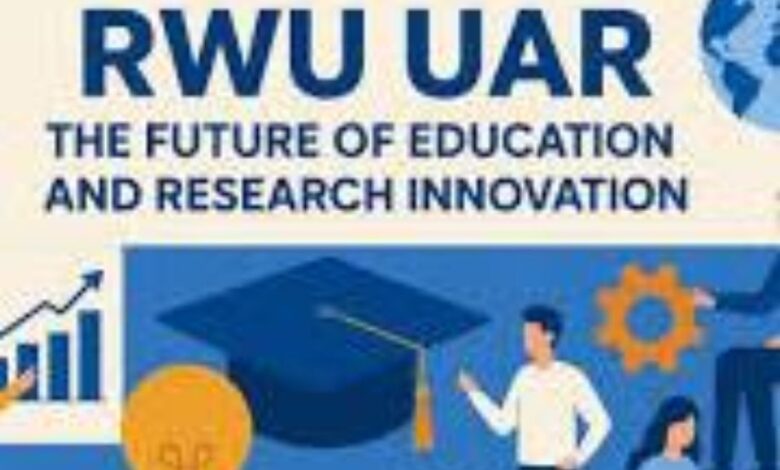RWU UAR: Meaning, Uses & Digital Transformation Explained

In recent years, the term “RWU UAR” has begun to appear across educational blogs, technology articles, digital transformation discussions, and academic forums. Although the phrase may initially look like a simple acronym pairing, its usage across the digital ecosystem reveals a surprisingly deep, multi-layered meaning. Today, RWU UAR is discussed not only as a combination of two independent acronyms—RWU and UAR—but as a conceptual framework often associated with education, research, digital modernization, automation, and academic transformation.
This article aims to provide the most comprehensive breakdown of RWU UAR available online. We will explore its meanings, applications, relevance in global education systems (especially in universities such as Rawalpindi Women University), and its role in modern technological innovation. Whether you’re a researcher, student, educator, or digital-transformation enthusiast, this in-depth guide will help you fully understand the growing buzz around RWU UAR.
What Does RWU UAR Mean?
RWU – A Multi-Meaning Acronym
The acronym RWU is used internationally across various fields. While its meaning depends heavily on context, common expansions include:
-
Rawalpindi Women University (Pakistan)
-
Roger Williams University (USA)
-
Reutlingen University (Germany)
-
Rail Workers Union (industrial sector)
-
In technology contexts: a shorthand used for Research-Work Units, Remote Work Utilities, or niche systems
Among these, Rawalpindi Women University is the most frequently referenced in blogs and educational articles combining RWU with UAR.
UAR – A Flexible, Technology-Driven Acronym
Just like RWU, UAR has multiple meanings depending on the field:
-
User Access Request (IT security & enterprise systems)
-
Undergraduate Academic Records / Research (academia)
-
Unified Automation Resource (tech/automation)
-
Universal Augmented Reality / Unified Augmented Reality (immersive tech)
-
University Academic Repository (education technology)
Because of its versatility, UAR has become a trending acronym in conversations around digital campuses, AI-powered data systems, IT workflows, and research management tools.
RWU + UAR: Understanding the Pairing
When combined, RWU UAR is often used in:
-
Articles describing universities improving their research, data systems, or academic portals
-
Blog posts discussing how educational institutions adopt digital transformation tools
-
Tech write-ups exploring automation and academic information workflows
In simple terms, RWU UAR usually describes a connection between:
A university or research institution (RWU) + a digital/academic/automation system (UAR).
This makes RWU UAR a term that symbolizes modern academic digitalization—a shift toward smarter, more integrated, and data-centered education.
RWU UAR in Higher Education: The University Perspective
Rawalpindi Women University (RWU) as a Central Example
Many blog posts associate RWU UAR with Rawalpindi Women University, an institution that represents a powerful example of modern educational growth.
RWU has evolved significantly over the decades:
-
Started as a women’s degree college in 1951
-
Upgraded to a postgraduate institution in 1983
-
Became Rawalpindi Women University in 2019, offering advanced programs
The university today emphasizes:
-
Research development (via ORIC and research centers)
-
Digital learning
-
International collaborations
-
Women’s empowerment through education
In this context, RWU UAR reflects the university’s vision of blending traditional academics with digital innovation.
Academic Portals & Student Records (UAR Component)
Universities worldwide are adopting systems for:
-
Student academic record tracking
-
Attendance monitoring
-
Research database management
-
User access authorization for digital systems
This is where UAR becomes extremely relevant.
When RWU deploys digital portals for student data, research archives, or automation systems, the term RWU UAR becomes a handy shorthand used in articles and blog discussions.
RWU UAR as a Digital Transformation Framework
Beyond universities, many tech writers interpret RWU UAR as a framework that blends research, utility, automation, and digital reality.
In this conceptual model:
-
RWU represents Research–Work–Utility
-
UAR represents Unified Augmented Reality / User Access Resources / Automation & Records
Together, the term is used to describe:
a. Smart Academic Ecosystems
Educational systems that incorporate:
-
Learning Management Systems (LMS)
-
Virtual classrooms
-
Digital assignment submission
-
Analytics-based student tracking
b. Automation in Administrative Workflows
UAR systems help manage:
-
Authorization requests
-
Academic record updates
-
Access permissions
-
Workflow automation
c. Augmented and Enhanced Reality Tools
Some modern UAR models include XR/AR to:
-
Enhance technical learning
-
Simulate real-world scenarios
-
Build virtual campus experiences
In this interpretation, RWU UAR symbolizes the merging of traditional education with next-generation digital tools.
Practical Applications of RWU UAR
1. University Management & Administration
Many institutions use UAR-based systems for tasks such as:
-
Digital document approval
-
Transcript generation
-
Departmental coordination workflows
-
User permission management
RWU UAR becomes a term used to describe a university actively integrating these systems.
2. Research Development & Collaboration
UAR-style platforms support:
-
Research data storage
-
Publication tracking
-
Collaboration among departments
-
International research partnerships
RWU’s engagement with guest scholars from the UAE, India, Nigeria, and others shows how research ecosystems rely on UAR-like structures.
3. Student-Centered Learning
UAR in education also enhances:
-
Personalized learning paths
-
Data-driven academic evaluations
-
Online resources and tutorials
-
Blended learning models
4. Business Automation in Education
RWU UAR concepts apply to academic-business integrations:
-
Automated fee management
-
AI-powered academic counseling
-
Automated scheduling
-
Real-time dashboards for decision-making
Benefits of RWU UAR Models
A. Enhanced Efficiency
Automated workflows reduce paperwork, delays, and human error.
B. Improved Learning Outcomes
Digital dashboards help teachers and students understand performance patterns.
C. Stronger Research Output
Centralized databases make collaboration and data retrieval faster.
D. Ease of Access
Students can access academic data anytime—attendance, grades, coursework, and records.
E. Future-Ready Skills
Exposure to AR, automation, and digital tools helps learners adapt to the digital economy.
Challenges Behind RWU UAR Implementation
While the system sounds ideal, real-world challenges exist:
1. Digital Literacy Gaps
Not all students or faculty are comfortable with advanced digital tools.
2. Infrastructure Limitations
Universities need stable internet, servers, security systems, and trained staff.
3. Data Security Risks
User Access Requests (UAR) require strict privacy and cybersecurity protections.
4. Implementation Costs
Large-scale transformation is expensive and demands long-term planning.
5. Change Management Issues
Introducing new digital tools often faces resistance from both students and staff.
These challenges make it essential for institutions to adopt RWU UAR models gradually, strategically, and with strong training support.
The Future of RWU UAR
The growing interest around RWU UAR suggests several future trends:
1. AI-Powered Academic Systems
Artificial intelligence will soon automate:
-
Grading
-
Personalized assignments
-
Academic counseling
-
Research mapping
2. AR/VR Classrooms
Virtual reality labs and augmented learning environments will expand widely.
3. Centralized Global Research Networks
Universities may interconnect research data and archives worldwide.
4. Fully Digital Campuses
From admissions to graduation, every step may become digitized through UAR workflows.
5. Smart University Ecosystems
RWU UAR might evolve into a global model that universities use to stay competitive in a digital-first world.
Conclusion
The term RWU UAR may appear simple at first glance, but its layers reveal a rich blend of academia, digital transformation, research development, automation, and futuristic learning systems. Whether referring to Rawalpindi Women University’s academic and research platforms, or more generally to institutional automation concepts, RWU UAR stands as a symbol of modern educational evolution.
As the world continues moving toward digital-first solutions, RWU UAR represents the merging of tradition and technology—a shift toward smarter campuses, empowered learners, and globally connected research environments.
This article is published on Blog Loom, your trusted destination for deep insights, tech explanations, and modern educational analysis.
You may also read: HCOOCH CH2 H2O: Formula, Uses, and Key Reactions


